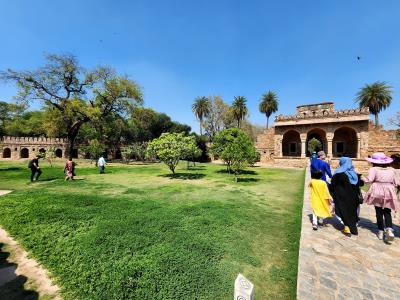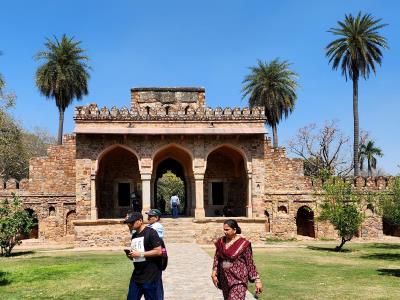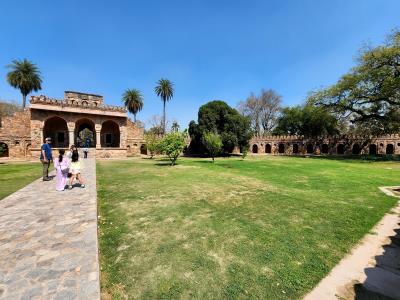Day 12 3/6/2023
India - Delhi
Frank's Trip
CLICK on any image to enlarge - use mouse cursor to move enlargement it if doesn't fit area

My last really full day...
The end of this trip is so close. Today, after getting rested up for 2 days, I made it a full day to see the last major thing I wanted to visit - the World Heritage Site of Humayun's Tomb - and a couple of minor stops along the way.
Sabz Burj was interesting, though not easy to get into and has the look of not being open at all - nothing there to invite guests in. In fact, a difficult spot to get to, an imposing fence and a gate that one has to look closely at to note it is actually open. Still, once in a brief visit was all that was needed and it was well worth the effort.
Humayun's Tomb Complex is very large and spread out. It has the obvious "tourist areas" but with a little effort tracks to places that are virtually unvisited can be found and some interesting things seen. These tend to be somewhat sad because of the deteriorating conditions of them. But the demands of restoring places and them keeping them in great shape must be immense so it is easy to understand how some places necessarily go downhill.
India Gate
Looking a little like the famous Arc de Triomphe in Paris, the equally impressive India Gate is a magnificent stone arch built as a memorial to Indian soldiers killed in WWI. An eternal flame burns beneath the massive structure, and its walls are inscribed with the names of more than 90,000 soldiers who died in the conflict.

Sabz Burj
Located at the busy intersection of two key arterial roads and in a traffic circle with only the smallest possible "sidewalk" around it, it takes a death wish to cross through the traffic (as it does anywhere else, too) to get in the gate to see this relatively recently discovered marvel.
Though it is said to be built in the 1530s, there is no record of who built the tomb and for whom. With the word “sabz” in its name means “green”, the tomb is largely covered in turquoise blue tiles. The lotus finial atop the dome and the neck, however, consist of green tiles. The incised plaster work also gives a hint of green color in parts. Experts say that the name of the monument might have originated through local folklore. While there was no grave at the mausoleum, one could estimate that the tomb belonged to an important nobleman since the ceiling was made of gold.




The monument was used as a police station in the early 20th century. During this period, the originally painted interiors were plastered over due to which much of the facade decoration was lost, and replaced with layers of cement. By the 1980’s, much of the tile work on the dome had fallen away and was re-tiled with modern tiles fixed with cement mortar. Restoration replaced tiles with ones exactly like the original tile work in all details.
A unique feature of the monument, that came to light during conservation works, was the revelation of a painted ceiling with detailed floral motifs and patterns created in real gold and lapis lazuli. Lapis lazuli, or lapis for short, is a deep-blue metamorphic rock used as a semi-precious stone that has been prized since antiquity for its intense color.
Taking into account the immense importance of the ceiling, no restoration of missing portions was carried out by the team. "The intricate pattern on the ceiling is made of pure gold and lapiz. This is the most historically significant element of the tomb. We tried to remove the layers and unveil the original ceiling as much as we could,” said Nanda.









The Hunayun Tomb Complex consists of several different parts and, together, comprise the World Heritage Site.
The various sections are:
- Isa Khan's Tomb & Mosque
- Arab Sarai: This was a safe house meant for craftsmen doing construction work.
- Humayun's Tomb
- Barber's Tomb
- Nila Gumbad or "Blue Dome"
- Bu Halima's tomb and garden
Gateway to Isa Khan's Tomb & Mosque
RIGHT: From the outside
BELOW: From the inside





Isa Kahn Tomb
Isa Khan Niyazi was an Afghan noble in Sher Shah Suri's court. He was actually an adversary of the Mughals and had fought against them. The octagonal tomb was built during the reign of Islam Shah Suri (1547 - 1548). It is surrounded by an octagonal garden and later went on to serve as the burial place for Isa Khan's family as well.














Isa Kahn Mosque












Arab Serai Gateway
According to Indian National Trust for Art and Cultural Heritage (INTACH) listing of ancient structures in Delhi, Arab Sarai was built in 1560 by Hamida Banu Begum, who was chief consort of Mughal emperor Humayan, to accommodate 300 Arabs she had brought back from Mecca. Ultimately, this became a safe area meant for craftsmen doing construction work.
This area isn't really open - the gates are kept locked. However, I happened along as some werkers and equipment were being let in and got a few pictures.





 Humayun's Tomb
Humayun's Tomb
Mid-16th century Humayun's Tomb is a lofty mausoleum constructed of white marble and red sandstone. Its design was a prototype for the Taj Mahal
As the name suggests, Humayun's tomb is the final resting place of the Mughal Emperor Humayun. Located in the Nizamuddin East area of Delhi, it is the first garden-tomb in the Indian subcontinent. This splendid piece of architecture was commissioned for construction by Humayun's chief consort Empress Bega Begum in the year 1569-70 and is one of the very few structures that used red sandstone on such a massive scale at that time. The design of Humayun's tomb is a typical Mughal architecture with Persian influences and was conceptualized by Persian architect Mirak Mirza Ghiyath.


























Aside from the main "room" with Humayun's Tomb, there are other rooms with several additional tombs.











From The Upper Plinth
The upper plinth is high enough that there are large birds flying below that level
Views from the upper plinth of the pavilions and gates
Barber's Tomb (below) can also be seen from a corner of the upper plinth






Barber's Tomb
Kings and queens have their magnificent tombs and so do their brothers, sisters and cousins. Tombs of favorite ministers and even dogs are also not uncommon. But a tomb of Emperor’s favorite barber is something rarely heard of. Humayun the second of great Mughal rulers honored his favorite barber with a beautiful tomb, located next to his very own magnificent mausoleum.










Nila Gumbad - Blue Dome
Historians are unsure about the identity of the person who has been buried. Some claims that it houses the tomb of an attendant of a Mughal noble and was buried during the reign of Jahangir. According to others, the tomb existed much before the Humayun's tomb was constructed.

Entry to Nila Gumbad











Bu Halima Gateway & Tomb
A rather short, rectangular structure which is easily ignored is the tomb of Bu Halima. The gateway seems grander than the tomb.
The architecture of this structure dates back to the mid-1500s. The tomb, rectangular in shape, seems to have been built with brightly colored stones which appear to have faded over time. Each of the four sides has two entrances carved out in them. There’s a staircase in front of this structure that leads up to its top. At the top is an octagonal platform and at the center of this platform is where But Ha lima is buried.
The exact identity of But Ha lima is a mystery but it’s said that she was Humayun’s wet nurse and also a Mughal noble woman. It’s evident that she must have held an important position to have a garden named after her and to have her tomb placed barely 100 meters away from Humayun’s.




LEFT: Gateway
RIGHT: One of the 8 identical entrances - 2 on each side - of the tomb.





